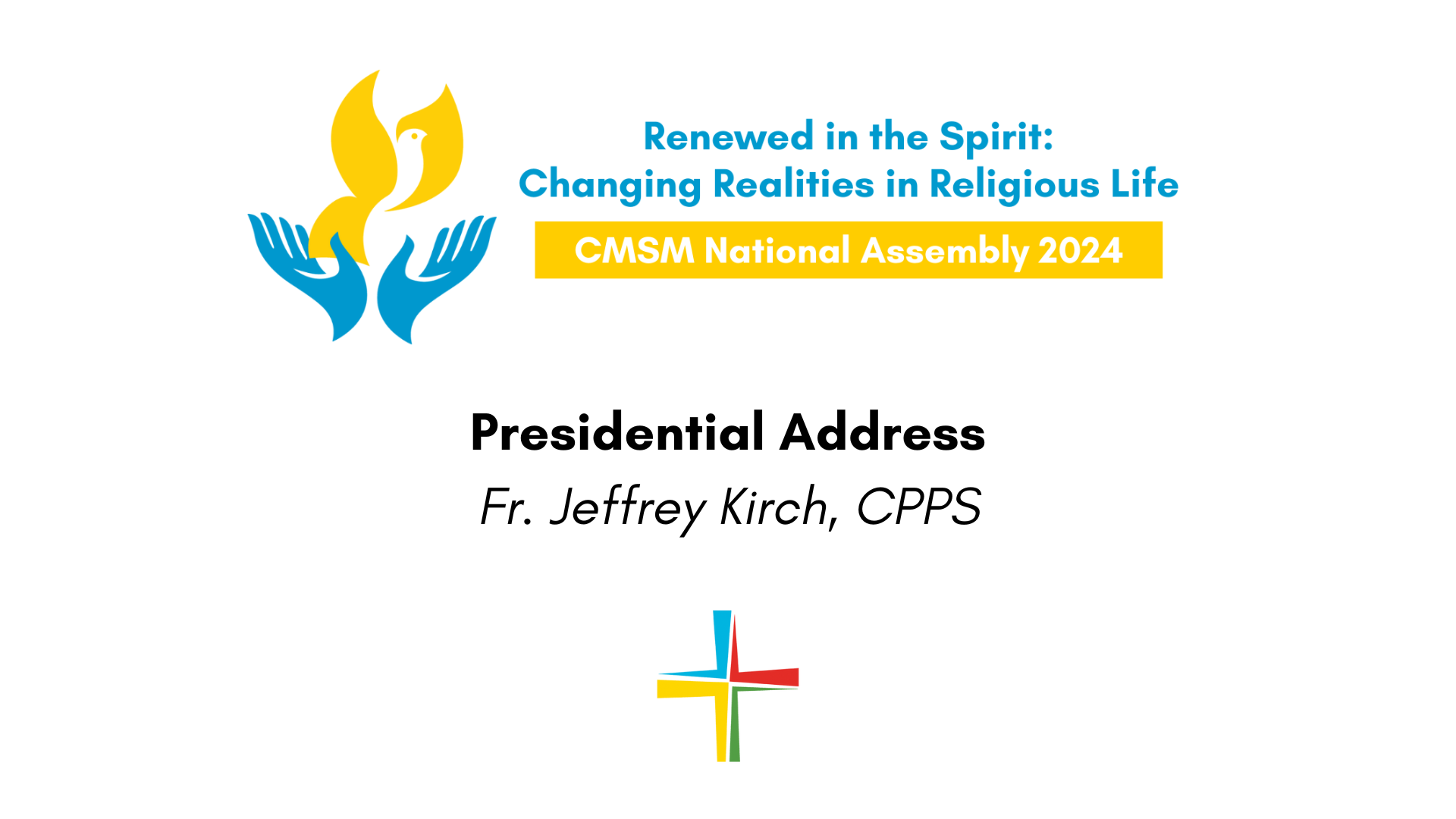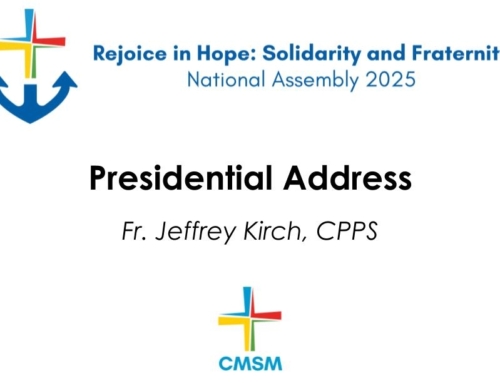Review for Religious is pleased to publish a copy of the Very Rev. Jeffrey Kirch, CPPS’s Presidential Address to the 2024 Assembly of the Conference of Major Superiors of Men. In his address, Fr. Kirch reflects on the changing realities that religious life faces today, addressing challenges such as diminishing numbers, aging populations, and excessive workloads. He emphasizes the need for a seismic shift in leadership, rooted in synodality, as a way forward and connects his insights to Pope Francis’s vision of the People of God, ongoing reform, and mission.
Click here to download a copy of the essay.
On behalf of the Board of Directors of the Conference of Major Superiors of Men I would like to welcome you to the 2024 National Assembly. Thank you for taking time out of your busy schedules to gather for these few days for fraternity and renewal. The various sessions of our assembly, from yesterday’s Pre-Assembly to the Post Assembly on Thursday, are rich sources to help each of us in our ministry of leadership.
In last year’s presidential address, I highlighted the role of charism in the life of our congregations, and most importantly in our role in elected leadership. This year I will shift to address our role as leaders in the changing reality of religious life. This focus flows from our theme of Renewed in the Spirit: Changing Realities in Religious Life. Within this brief address I will offer a glimpse of the current context that we find ourselves in, both from the leaders’ perspective and from a congregational perspective. Second, I will argue that we must make a seismic shift in order to adequately address this changing reality.
Current Context: Changing Realities
There is no doubt that our world is in a state of perpetual change. Events that profoundly effect peoples’ lives seem to be occurring at a perpetually faster pace. Spurred on by developments in technology, the push and pull of globalization, and the twenty-four hour news cycle, our world is changing. This is not a new phenomenon. The world has always been changing, for that is the trajectory of creation and human nature. What is new for us is the pace of development. In prior years, one could be confident that you were getting up-to-date news by reading your morning paper. Now, you get your news instantaneously on your Twitter feed or Tik Tok. Technology, politics, and economics contribute to our changing world.
Our focus in this address is not the sociological or technological changing reality, but the context of changing realities in religious life. We will approach this from the perspective of leadership and from the congregational level. The Conference of Major Superiors of Men commissioned CARA, the Center for Applied Research in the Apostolate, to survey our members on various issues they are facing. The results of the survey, which were shared last year, helped the National Board to set priorities for the work of the conference.
The three top challenges which leaders identified were: 1) diminishing numbers; 2) aging population; and 3) excessive workload. Each of these have a profound effect on the individual leader and on the exercise of leadership. First, let us turn to diminishing numbers. For most of our congregations, the large number of vocations as experienced in the 1940s and 1950s is clearly in the rear-view mirror. The vast majority of the Conference’s members fall into the smallest two categories of member size. Formation cohorts of ten to fifteen have for the most part been replaced by classes of one or two. This puts profound pressure on leadership in the areas of formation, community life, and mission. Many of our current congregational structures were developed with larger numbers in mind. A formation program of two candidates requires a completely different approach than a program of twenty. Stresses on community life are apparent when an increasing number of members are living further and further away from each other. And a lack of vocations ends up forcing the leadership team to “right size” pastoral commitments. For each of these areas, this changing reality puts tremendous stress on leaders.
The next two challenges identified in the CARA study, aging and excessive workload, are intimately tied to the lack of vocations. Today, this room looks very different than it would have in the 1980s or even the 1990s. Many of the leaders of our congregations from the 1990s may still be in leadership at an even older age than their predecessors. Aging leadership is coupled with aging membership. The overall aging of religious life in the United States puts pressure on the individual religious, the apostolate, and the community. We are asking our confreres to minister more and longer. This raises questions of justice, especially when coupled with the third challenge from the CARA survey, excessive workload. In many communities, a major superior not only has a full-time ministry in governance, but also may serve as a pastor or another role at the same time. On top of increased diocesan and safeguarding bureaucracies, the workload for many leaders has become unmanageable, which quickly leads to spiritual fatigue and burnout.
These changing realities have a profound effect on the health, wellbeing, and ministry of not only leaders, but congregations themselves face a changing context with which they must contend with. These changing contexts influence the life and mission of a congregation. Religious life, especially in the United States, is finding itself in an ever more secular context. By that I mean, the level of cultural Christianity that once could be expected in the public square is absent. Cultural Christian literacy, knowing who Jesus was, having heard of the ten commandments, understanding what Easter refers to, in recent decades has waned. The growth of the “nones” and a civic life devoid of all reference to religion is the world many congregations find themselves in. It is not that portions of the population are anti-religious, instead religious life and religion itself are not relevant to some people’s daily lives. This secular context adversely affects not only vocation efforts, but the effectiveness of mission as well.
In addition to a growing secular context, congregations are facing an ever more polarized world, both politically and ecclesiologically. The polarizing forces causes levels of discomfort when encountering the other. Pastors are valiantly trying to minister to red and blue parishioners. Internally, they are also holding the tension between people calling for more traditional expressions of the faith and those who are calling for a greater focus on the social gospel. While these two foci, and those similar, are not mutually exclusive, to hold both in tension becomes ever more difficult in our Church and world.
The final challenge facing our congregations in our changing reality is the internationalization of our congregations. This is not a new phenomenon in religious life. Most of our congregations are international and throughout history, members of our congregations have ministered in foreign lands. But in the United States, when the large waves of immigrants came in the 1800s and early 1900s, each immigrant community brought religious with it – the Germans brought German religious with them, the Irish brought Irish religious, and so forth. What is different now, is that, for example, my congregation with its roots in the German migration to Ohio in the 1840s now has three Tanzanians and an Indian confrere ministering with us. The international and multicultural context of many of our congregations will continue to grow and bring with that growth a certain level of difficulty in mission and community life.
Our leaders and our congregations have found themselves in a context marked by profound change. Internally, leadership faces difficulties due to a lack of numbers, an aging membership (including themselves), and an excessive workload. At the larger congregational level, communities are experiencing stress from wider movements in the world such as secularization, polarization, and globalization.
Response of Leadership
Having attended to some trends in the changing realities we are facing, how do we respond? Certainly a response is needed, but what kind of response would be most effective and fruitful for male religious life in the United States?
It is clear that the changing realities religious life is facing in the United States today call for a robust response. We cannot ignore the context we find ourselves in today. Refusing to respond to the challenges surfaced through the CARA survey will only ensure a continued decline in religious life. However, in our response we cannot rely upon structures and strategies from the past. The changing reality calls for new wineskins. The old ecclesial structures and strategies served religious life and the Church well, but that was a different context and time. The question is how do we respond effectively in today’s environment?
I will briefly highlight three areas which I call for new wineskins. In many dioceses parochial life is at a crossroads. And to the extent that our congregations minister in a parochial environment, our mission is at a crossroads. Demographic changes have necessitated a restructuring of parishes, in both city centers and in rural areas. A lack of vocations has certainly contributed to the need for restructuring, but also in many dioceses, the physical parish church is no longer located where it needs to be. The population has moved. Mergers, closures, and clustering are often the answers that bishops fall back on. And we as religious often become part of these strategies.
While this may seem inevitable, the question that we should be asking concerns the whole premise of the parish itself. Is the parochial structure the most effective structure for evangelization? The traditional parochial structure certainly met a real need at one time in the United States, and in many areas probably still does. But one size does not fit all. How can we reimagine our efforts to reach those who do not enter our parishes for a variety of reasons? How can we open the walls of our churches, so that instead of an insular, self-contained parish, we have a mission of “going out”? Our leaders today need to have the imagination to rethink mission to be more effective.
The second of our new wineskins was discussed earlier. The old structure of leadership in our congregations will need to develop. Due to the pressure of demographics and aging, the old structure of fifty-year-olds serving as provincial directors and then being replaced by the next set of fifty-year-olds is not practical today for most communities. Our leaders skew older and are being recycled. While these sages bring much wisdom to the community, how just is it to ask an eighty-five-year-old religious to serve in leadership? At the other end of the spectrum, we are often pushing younger members without much leadership experience into positions they may not be ready for, both in congregational and ministerial leadership. The old paradigm no longer works. Most of us cannot afford to have a newly ordained priest serve as an associate for eight to ten years before becoming a pastor. As leaders, we must address this and it will require thinking outside of the box. How do we support our confreres who seemingly are asked to spend decades in leadership until they drop dead, and how do we prepare our younger members to step up? CMSM has been developing resources for this.
To draw this section to a conclusion, I have argued that the response of leadership to the changing realities of religious life cannot rely on old structures. They no longer work. We have to rethink how we live religious life today. The change, I believe we need to make, is not a programmatic change. A new prepackaged program is not what we need in order to effectively contend with the reality we find ourselves in. The time for tweaking this aspect of our governance structure, or our mission, or our personnel policies has long passed. In the United States today, we need a seismic shift in our approach to leadership and religious life at large. Like all seismic events, the earth will tremble and some things will break and topple, but the core of the faith will hold. Much like the seismic shift that occurred at the Second Vatican Council, this new seismic event is really an old one. Just as the Council fathers returned to the sources and reached deep into the tradition, Pope Francis is calling on us to do that as well.
Seismic Response: Synodality
I am arguing that the best way for our congregations’ leaders to deal with the changing realities we face is through the lens of synodality. As a Church and more specifically as religious communities, we must realign our vision to the reality we are facing. That is the only hope we have for ensuring our mission is effective in this new environment. While the old wineskins served us well in the past, they no longer are useful. Pope Francis’s vision of a synodal Church, and by extension I would argue more synodal religious communities, equips us to negotiate these changing realities. In this section I will briefly touch on three elements of synodality that may be helpful for leaders of congregations as they face the challenges outlined above.
In an address commemorating the 50th anniversary of the founding of the Synod of Bishops, Pope Francis presented a refreshed way of understanding the Church. He called for a “synodal Church that listens, with the understanding that listening ‘is more than hearing.’ It is reciprocal listening in which everyone has something to learn” (Luciani, 2). His understanding of a synodal Church is much more than an ecclesial structure or program. Instead, it is a way of existing. It is a way of being and positions the Church and religious communities to respond to the signs of the time and hear where the Spirit is calling us.
Francis’s understanding of synodality is supported by three important concepts that bear directly on religious life today. These three concepts can play a major role in our attempts to respond to the changing reality of religious life in the United States today. Paying attention to these important hallmarks will give us the ability to deal with the diminishing number of vocations, the aging membership, and the excessive workload CMSM members have identified as the three most serious challenges we face today. These three concepts are: people of God, reform, and mission.
People of God
First, the keystone to any synodal understanding of Church and religious life is the theological concept of “the people of God.” Rooted in the ecclesiology of the Second Vatican Council, Francis highlights that “Church” refers to the whole people of God. Baptism is the foundational sacrament. This understanding widens our concept of membership and role. All the baptized have a role in the mission of the Church. Distinctions of office and rank are all secondary concepts to the foundational understanding of the Church encompassing everyone, in varying degrees of association. Francis highlights this element in Evangelii Gaudium in which he argues that all of the baptized have to become missionary disciples and that this charge is not dependent on theological training or office in the Church. This responsibility flows from our baptism into the life of the Trinity (EG, 120). A portion of Evangelii Gaudium reads, “The Samaritan woman became a missionary immediately after speaking with Jesus and many Samaritans come to believe in him “because of the woman’s testimony” (Jn 4:39). So too, Saint Paul, after his encounter with Jesus Christ, “immediately proclaimed Jesus” (Acts 9:20; see also 22:6-21). Francis asks, “What are we waiting for?” If the Samaritan woman and St. Paul can immediately go and invite others to relationship with Christ, Francis challenges us as leaders as well. How are we broadening our understanding of religious life, without compromising our charisms, so that we are attracting more people? How might the structures of membership evolve to encompass other forms of membership? How can we as leaders be more inviting? How do we as a Church and as congregations understand what our fellow baptized Christians are longing for and how can we welcome them?
Reform
Francis picks up on another development at the Council regarding the synodal Church which has serious ramifications for religious life. Francis often speaks of the Church in a state of permanent reform. The Church is the pilgrim people of God. The modifier, pilgrim, points to the Church “being on the way; in transit; journeying.” There are connotations of reform. In its response to the call of the Gospel and the signs of the times, the Church is always making the necessary changes to be more faithful to the call of Christ.
As we think of the synodal journey, the simplest way to understand it is “walking together.” This is, however, just the tip of the iceberg. We are called to do more than walk together. Francis understands synodality as a spiritual process in which through reciprocal listening the Church comes to understand the path that God is calling us to take. “It involves the dynamic of praying, meeting, and working together, but also of discerning, and making and taking decisions together…A synodal model involves the entire ecclesial community to seek new ways of proceeding as one people of God living in a multiform communion” (Luciani, 3). Reform is not a one-time event or even just the updating of structures. Due to our persistent need for conversion, the reform envisioned in a synodal Church is a “constant process of ecclesial conversion involving the whole Church” (Luciani, 16).
Religious life in the United States is very different today than in 1965. Religious life in the United States will be very different today than in 2065. Ongoing reform is essential to the religious life. As leaders, how are we ensuring that our congregations are agile enough to respond to changing contexts? How do we form our confreres with the tools necessary to recognize the changing context and respond appropriately out of our charisms and the Gospel?
Mission
Throughout Evangelii Gaudium Francis references the missionary stance of the Church. For Francis, mission is not what the Church does; rather, it is a constitutive part of the Church’s very nature, of what it is. In paragraph 24 he speaks of a “community of missionary disciples.” Roger Schroeder, in his book What is the Mission of the Church?, notes, “Christians as missionary disciples, following the example of the Samaritan woman at the well, are almost compelled by their experience of God’s love and grace to share this with others, both with and without words” (Schroeder, 97).
At the heart of religious life is our relationship with Jesus Christ. We have left all to follow him. If we are compelled by our relationship with Christ to evangelize, then we really do not have an option, if we are to be faithful to Christ. Francis writes, “Throughout the world, let us be ‘permanently in a state of mission.’” (EG, 25). Flowing from the notion of the Church as the whole people of God, this mission is not reserved to the experts. Because this missionary mandate is all encompassing, no part of the life of the Church is left untouched. The call to mission permeates throughout the life of the Church.
Each of our congregations have a charism gifted by the Holy Spirit. That charism is our charter, our reason for being. Rooted deep in each of those charisms, whether it is apostolic or contemplative, is mission. It is through our mission that the Spirit fills the world. As leaders, it is essential for us to be clear on the mission of our congregations. In responding to the changing realities around us, our mission guides us through uncertain waters. It is our compass. As I stated last year, the primary ministry of leadership is care of the charism.
Conclusion
In this address I have attempted to name elements, especially demographic, of the changing reality we are facing, both as leaders and as congregations. Our response cannot rely on old structures and programs, instead a seismic shift is needed. I believe that Francis’ understanding of synodality is a viable way to respond to a changing context well into the future. Synodality, with its emphasis on the people of God, ongoing reform, and commitment to mission provide religious communities with the tools needed to understand where the Spirit is calling us and to truly be Renewed in the Spirit.
Works Cited
Pope Francis, Evangelii Gaudium, November 24, 2013, https://www.vatican.va/content/francesco/en/apost_exhortations/documents/papa-francesco_esortazione-ap_20131124_evangelii-gaudium.html.
Luciani, Rafael. Synodality: A New Way of Proceeding in the Church. Maryknoll, NY: Orbis, 2022.
Schroeder SVD, Roger. What is the Mission of the Church? Maryknoll, NY: Orbis Books, 2008.






